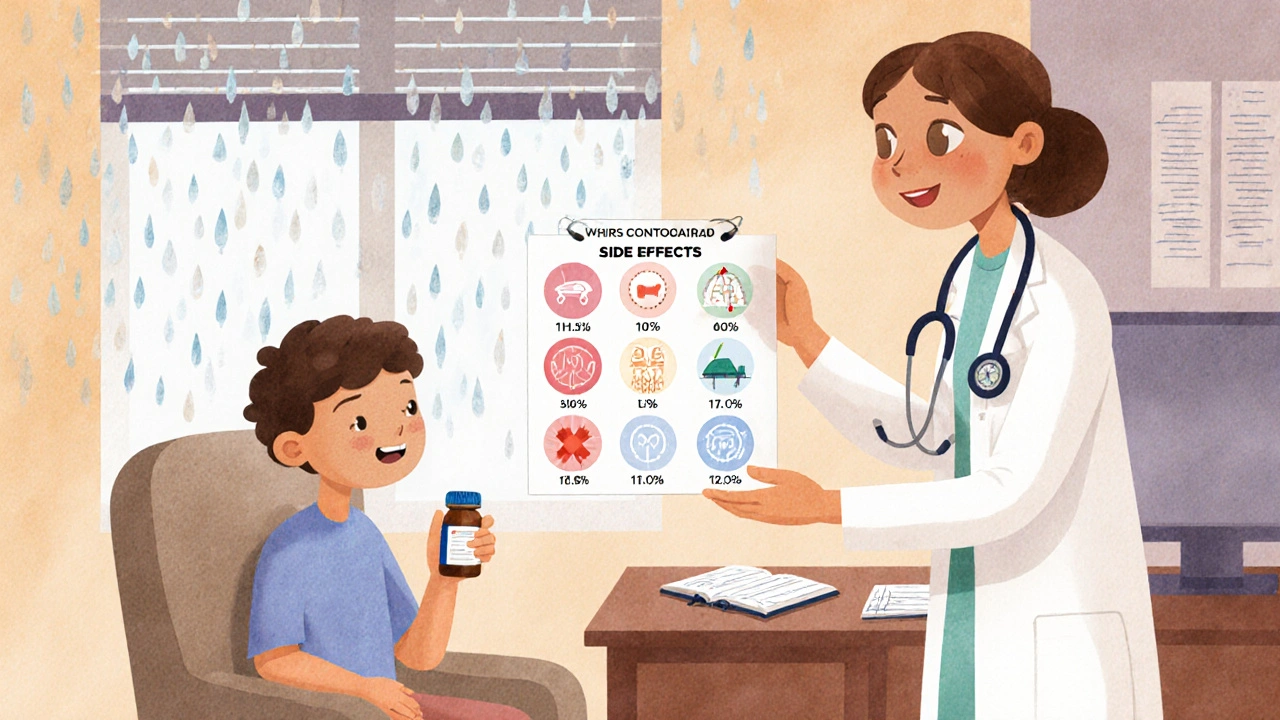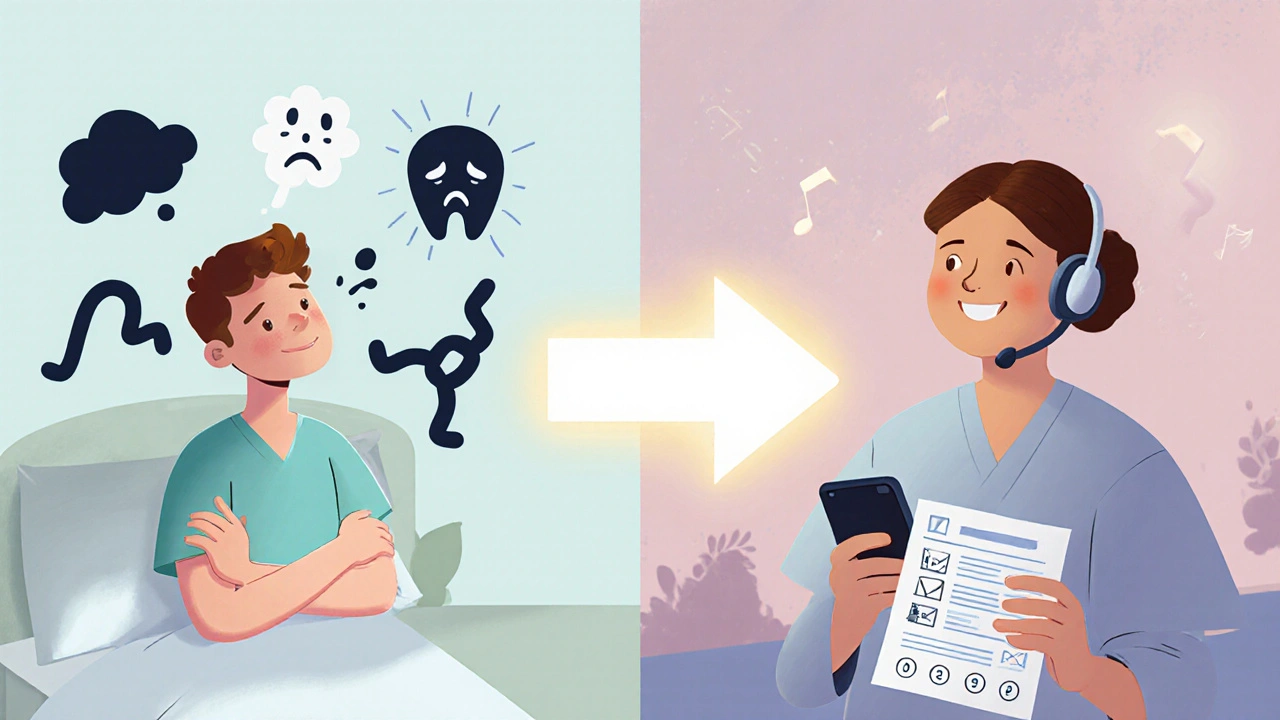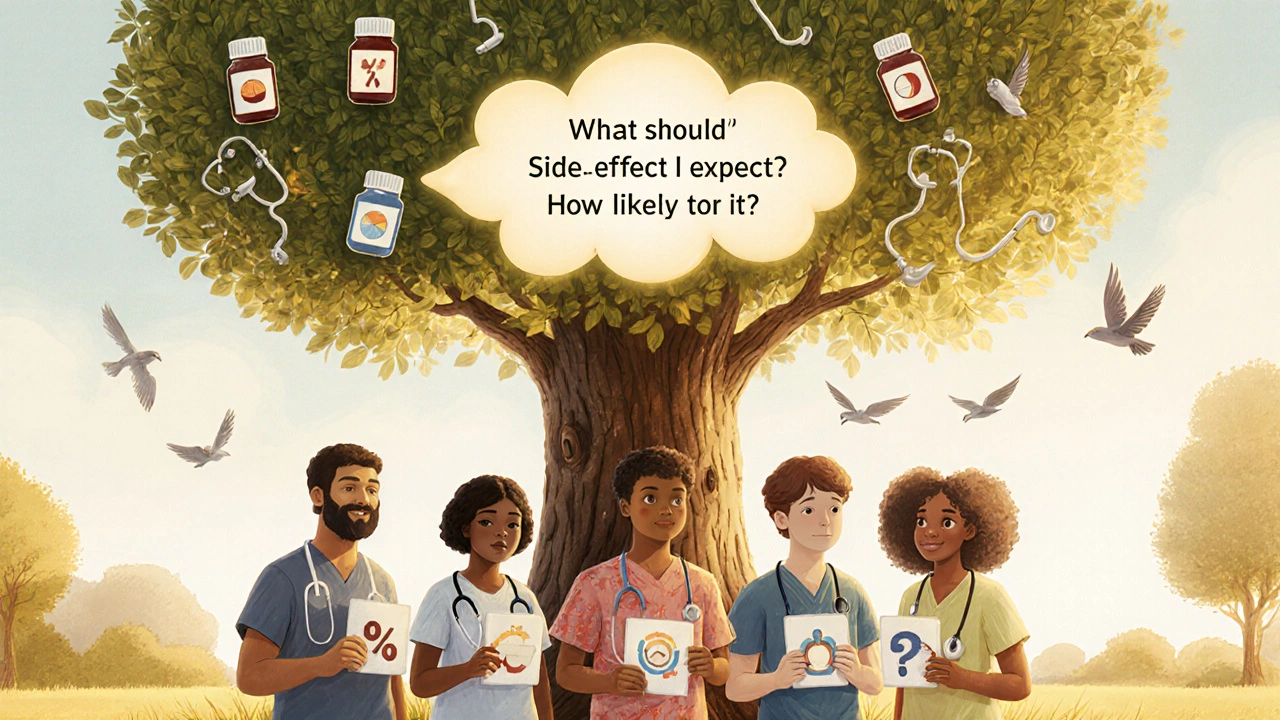How to Talk to Your Doctor About Side Effect Burden
 Oct, 27 2025
Oct, 27 2025
Side Effect Frequency Converter
The article explains that vague terms like "common" or "rare" create confusion. This tool converts those terms to specific percentages to help you discuss side effects with your doctor.
What This Means
Based on FDA and medical guidelines:
- Very common: >10% (1 in 10 or more people)
- Common: 1-10% (1 in 10 to 1 in 100)
- Uncommon: 0.1-1% (1 in 100 to 1 in 1,000)
- Rare: <0.1% (less than 1 in 1,000)
When you start a new medication, your doctor might say, "Common side effects include headache and dizziness." But what does "common" really mean? One in ten? One in a hundred? And what happens when you get a headache so bad you can’t work, but no one told you it could happen? You stop taking the pill - and your condition gets worse. This isn’t just bad luck. It’s a communication gap that affects millions.
Why Side Effect Burden Matters More Than You Think
Side effect burden isn’t just about discomfort. It’s about whether you stick with your treatment. Studies show that 68% of patients stop taking their meds because they weren’t warned about side effects - or the warning was too vague. That’s not just a personal problem. It drives up hospital visits, emergency care, and overall healthcare costs by billions each year. The truth is, most doctors don’t talk about side effects the way patients need. On average, they mention only 3.2 side effects per medication. But most drugs have 15 to 25 possible reactions listed in the official data. That leaves a huge blind spot. And when patients feel uninformed, they lose trust. In fact, doctors who clearly explain side effects get average ratings of 4.7 out of 5. Those who don’t? Just 3.2.What Patients Actually Want to Know
It’s not about listing every possible side effect. That overwhelms people. It’s about giving them what they need to make smart choices. A 2023 study found three clear patient preferences:- 49% want details on both common and serious side effects
- 26% only want to know about dangerous ones
- 17% only care about the mild ones
The Nocebo Effect: When Talking About Side Effects Makes Them Happen
There’s a paradox here. If you don’t talk about side effects, patients stop taking meds. But if you talk about too many, you might actually cause them. This is called the nocebo effect. It’s the opposite of placebo. When you expect something bad to happen, your body can make it happen - even if the drug isn’t causing it. One study found that patients who were told about side effects were 26% to 40% more likely to report them, even when taking a sugar pill. So the goal isn’t to scare you. It’s to prepare you - without triggering anxiety. That’s why the best approach is risk-stratified communication: focus on what matters most to you.
How to Have a Better Conversation
You don’t have to wait for your doctor to lead. You can take charge. Here’s how:- Ask about your preference: Start with, "How much do you think I should know about side effects? I’d like to hear about the ones that are common and the serious ones." This tells them you want real info, not a generic list.
- Ask for numbers: Don’t accept "common" or "rare." Say, "What’s the chance I’ll get this? Is it 1 in 10? 1 in 100?" Most doctors can give you a range if you ask.
- Ask for solutions: "If I get nausea, what should I do?" "Is there a way to reduce this side effect?" "Should I take it with food? At night?" This turns fear into action.
- Ask about trade-offs: "Will this help my pain more than the side effects bother me?" "Are there other options if this doesn’t work?" This puts the decision back in your hands.
What Your Doctor Should Be Doing
The best practices aren’t secret. They’re backed by the American Medical Association and the FDA:- Use clear frequency labels: Very common (>10%), Common (1-10%), Uncommon (0.1-1%), Rare (<0.1%)
- Separate side effects from allergic reactions - they’re not the same
- Focus on the top 3-5 side effects: what’s likely, what’s serious, and what you can do about it
- Use written materials: Patient guides, apps, or printed sheets help you remember
- Check in after 1-2 weeks: "How are you doing with the side effects?" - not just, "Are you taking it?"
Technology Is Helping - But Only If You Use It
Electronic health records now have built-in side effect tools. Some apps, like Medisafe, use data from over a million users to predict which side effects you’re most likely to get - with 76% accuracy. But only 37% of primary care doctors use these tools regularly. If your doctor doesn’t offer digital tools, ask. Say, "Is there an app or handout I can take home?" Or download one yourself. Many are free and let you log symptoms, track when they happen, and share reports with your doctor.
What to Do If You’ve Already Stopped Taking Your Meds
If you’ve quit a medication because of side effects - don’t feel guilty. Just don’t stay silent. Call your doctor. Say: "I stopped taking [medication] because I had [side effect]. I know it’s important, but I couldn’t handle it. Can we talk about other options?" Doctors who respond with curiosity - not judgment - see better outcomes. In fact, patients who feel heard are 22% more likely to restart treatment.Why This Conversation Is Your Right
You’re not being difficult. You’re being smart. Side effect communication isn’t just a medical formality. It’s part of your right to informed consent. The FDA requires certain drugs to come with Medication Guides for a reason - because people deserve to know what they’re signing up for. And as more people take multiple medications - the average adult over 65 takes nearly five - the risk of side effect interactions grows. Clear communication isn’t a luxury. It’s a necessity.Final Thought: Your Voice Changes Outcomes
You don’t need to be an expert to have this conversation. You just need to ask. "What should I expect?" "How likely is it?" "What do I do if it happens?" The more you ask, the more doctors will learn to answer. And the more patients like you speak up, the more the system will change.How do I know if a side effect is serious enough to call my doctor?
Serious side effects are those that could be life-threatening or cause lasting harm - like chest pain, trouble breathing, severe rash, yellowing skin, confusion, or sudden weakness. If you’re unsure, call your doctor. Better safe than sorry. For mild side effects like headache or mild nausea, track them for a few days. If they don’t improve or get worse, reach out.
Can I refuse to take a medication because of side effects?
Yes. You have the right to refuse any medication. But don’t just stop - talk to your doctor first. They might be able to adjust the dose, switch to another drug, or suggest ways to manage the side effect. Stopping without a plan can make your condition worse.
Why do doctors seem to downplay side effects?
Some doctors worry about causing anxiety or triggering the nocebo effect. Others are pressed for time - a typical visit lasts 15 minutes, and they have to cover multiple issues. But this isn’t an excuse. If you feel rushed, say so. You can ask for a follow-up visit or request written materials. Your health is worth the time.
Should I talk to my pharmacist instead of my doctor about side effects?
Pharmacists are excellent resources - they know drug interactions and side effect patterns better than most. Many patients prefer getting side effect info from both their doctor and pharmacist. But your doctor still needs to know what you’re told, especially if you’re on multiple medications. Use both: doctor for overall plan, pharmacist for details.
Are there tools I can use at home to track side effects?
Yes. Free apps like Medisafe, MyTherapy, or even a simple journal can help. Write down: what you took, when, what side effect you felt, how bad it was (1-10), and what you did about it. Bring this to your next appointment. It helps your doctor see patterns you might miss.

Kevin Ouellette
October 28, 2025 AT 01:42Love this post! 🙌 Seriously, doctors need to stop saying 'common' like it's a magic word. I had a med that gave me nausea 1 in 3 times - no one told me that. I thought I was broken until I found this exact guide. Now I ask for numbers. It changes everything.
Tanya Willey
October 29, 2025 AT 15:17Of course they don’t tell you the real side effects. Big Pharma pays them to keep it vague. You think that 3.2 number is accidental? Nah. They’re hiding the truth so you keep buying pills. Wake up, people. 🕵️♀️
Wiley William
October 30, 2025 AT 18:11Stop being so naive. Doctors don’t care about your headaches - they care about their quotas. The nocebo effect? That’s just a fancy word for ‘we’re too lazy to explain.’ If you’re getting side effects, it’s because the drug’s toxic. Period. 🤡
Richard H. Martin
November 1, 2025 AT 06:15THIS. IS. NON-NEGOTIABLE. If your doctor doesn't give you percentages, fire them. Full stop. We're not in the 1950s anymore. You have a RIGHT to know. The FDA has guidelines. They're ignoring them. And you? You're letting them get away with it.
Tim H
November 2, 2025 AT 20:51bro i had this one med that made me feel like i was floating but no one said anything so i thought i was dying. then i googled it and it was like 1 in 20. why dont they just say that? i almost quit my job because i thought i was losing my mind 😭
Vishnupriya Srivastava
November 4, 2025 AT 06:59Statistically, the data presented here is sound but lacks longitudinal validation. The 68% non-adherence rate is frequently cited but conflates self-reported behavior with clinical outcomes. Also, the nocebo effect is overstated in observational studies due to recall bias. Consider this: if patients were truly uninformed, why do adherence rates vary so wildly across cultures?
Matt Renner
November 4, 2025 AT 20:14This is an exceptionally well-researched piece. The emphasis on risk-stratified communication aligns with current patient-centered care models endorsed by the Institute of Medicine. I encourage clinicians to adopt the four-question framework outlined here as a standardized script. It reduces anxiety, improves compliance, and ultimately saves lives.
Pradeep Meena
November 5, 2025 AT 16:36Why you always blame doctors? In India we don't even get 1 minute with doctor. You think they have time to explain 15 side effects? You pay $500 for appointment? No. You wait 3 hours. Then doctor say 'take this' and go. This is not America. This is real life.
Kshitij Nim
November 5, 2025 AT 23:05My mom was on blood pressure meds for years and never knew she could ask for numbers. She stopped taking them because she got dizzy - thought it was her age. We found out later it was in 1 in 8 people. She started asking questions after reading this. Now she’s doing better than ever. Thank you for this.
Scott Horvath
November 7, 2025 AT 19:31so like… i used to think doctors were gods until i realized they’re just people who read a 200 page pamphlet for 5 minutes before seeing me. i now ask ‘what’s the 1 in 10 thing?’ and they usually pause like i asked them to solve quantum physics. then they give me the number. weird how simple it is
Armando Rodriguez
November 9, 2025 AT 00:33Excellent framework. The four questions you’ve outlined should be integrated into electronic health record prompts. Clinicians are not intentionally withholding information - they’re overwhelmed. A standardized, templated approach can empower both parties without increasing cognitive load. This is public health innovation in its purest form.
jennifer sizemore
November 9, 2025 AT 04:55YES. I used to be so scared to talk back to doctors. But after I started saying ‘I want to know the real numbers,’ everything changed. I even got my sister to do it. She’s on antidepressants now and actually sticking with them. It’s not about being rude - it’s about being brave.
matt tricarico
November 10, 2025 AT 17:25How quaint. You assume doctors are the gatekeepers of truth. But the real issue is the pharmaceutical industry’s manipulation of clinical trial reporting. The ‘1 in 10’ statistic you cite? Often comes from cherry-picked Phase III data. The real incidence? Hidden in post-marketing surveillance. You’re being sold a narrative dressed as empowerment.
Patrick Ezebube
November 12, 2025 AT 11:41They’re lying. Every single one. The FDA has a secret list of side effects they don’t allow doctors to mention. I’ve seen the documents. The headaches? The dizziness? Those are just the tip. The real ones - memory loss, suicidal thoughts, organ damage - they bury it in the fine print. You think they care if you live or die? They care about your insurance payments.
jerry woo
November 12, 2025 AT 19:56Let me tell you about the time I took that ‘common’ nausea med and ended up hallucinating my cat was a sentient toaster. No one warned me. The doctor said ‘mild GI upset.’ Mild?! I thought I was dying. Then I Googled it and found 1 in 50 people get full-on trippy vibes. So yeah - stop being vague. Say ‘you might see your dog whispering in Klingon.’ Then I’d be prepared.